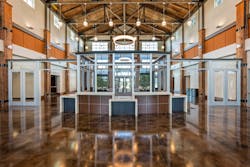Download the full PDF of the supplement here.
Threats of crime and acts of terrorism are becoming more prominent in today’s society, especially in metropolitan areas. In the unfortunate event that something of this scale happens in your town, your essential facilities must be ready for anything and able to protect the occupants inside. “Essential facilities” include fire stations, police stations, emergency operations centers (EOCs) and schools. It would be increasingly difficult to respond to an emergency of this kind if your fire station and its occupants are compromised.
One of the best ways to ensure the safety of your essential facility is through target-hardening. Target-hardening is defined as taking measures to make committing an attack on your facility more difficult and reducing the opportunities for criminals to achieve their goal. It would be nearly impossible to make a facility completely attack-proof, but the goal is to make the attack more difficult and risky for the perpetrator.
By their nature, fire stations have some limitations from a fully secure or hardened exterior from all potential threats. However, certain measures can enhance the safety and time for personnel to respond. This article assumes some of the more common countermeasures but is not all-inclusive, as each community will have different setting and site details to consider.
How can I target-harden my fire station?
Whether you have an existing fire station or are considering building a new station, there are actions you can take to harden your facility from attack. Target-hardening components in a facility are categorized by the type of attack they oppose, such as forced entry, explosives and toxins/airborne agents.
Forced entry can be deterred by installing toughened glass made of acrylic or polycarbon as well as installing latticework or screens in front of windows. Metal door and window shutters are also effective. Deadbolts and vertical-bolt locks, door anchor hinges with non-removable pins, and tamper-proof exterior screws in fittings can deter forced entry by making it more difficult to gain access through traditional means of entry. Vertical metal or small-mesh fencing and steeply angled roofs with parapets and ridges are difficult to climb.
Apparatus bay doors, however, present a unique breach or intrusion point that many operational policies will decline to address out of tradition, a policy that only each fire department can address. Bollards are a common hardening tool, as they prevent vehicles from ramming the facility.
Bollards also create a stand-off zone, thus making an explosive less effective. Any stand-off distance helps increase the chance for survival and minimizes damage to the nearby structures.
Ben Cole, PE, principal and senior mechanical engineer with TLC Engineering for Architecture, has many years of experience in target-hardening facilities to prevent toxins and airborne agents from entering the structure. For your station’s HVAC system, the primary concern is the protection of openings. Cole suggests locating outside air intakes as high and inaccessible as possible to decrease the possibility of someone throwing an object into the air intake. For an existing station, one solution is to put burglar bars or welded mesh on the air intakes instead of attempting to relocate them. This can prevent entry and/or the introduction of something chemical or biological into the station.
Another recommendation is an emergency shutdown for the HVAC system. If there is a perceived threat, the occupants can shut the system down so it would no longer distribute through the building. To take it one step further, an exhaust for the entire facility can be installed. This is helpful in an area where mail or packages are delivered or stored. If a package or envelope contains a suspected biological threat, the occupant has the capability of activating an exhaust fan to isolate the threat and remove it entirely from the building.
From an electrical standpoint, the outside transformer is a critical area to protect by isolating and enclosing it. If the local fire marshal requires the facility to have an exterior disconnect switch, a solution is to install a cage to protect it. The way these cages are designed, fire marshals can use their regular key to access the switch if needed.
Electrical systems must have enough capacity to support all security measures that are installed, such as door access systems and cameras. Also helpful in an event of this magnitude is an early warning alarm with emergency buttons throughout the facility. This system must be backed up with a powerful generator in the event of an outage.
Cole’s recommendation for the building’s plumbing system is the installation of a back-flow preventer outside of the building. In major cities where the fire station ties into the main water supply system, this prevents contamination from your building into the main supply. The back-flow preventer is typically installed outside the building, but the building user may opt to locate it inside the building. If the back-flow preventer must be outside, then it should be protected from tampering.
How do I pay for this?
A security threat assessment can be conducted to both generally identify the types of threats and preventions that are relevant to your circumstances and context and the measures that are practical for consideration at a specific existing station or new station planning effort. Security consultants and architects who design fire stations can help you with an assessment to determine your options for hardening your facility. These options can translate into cost estimates, which can then be added in to your upcoming budgets in order to begin implementation.
For the fire departments located in high-threat, high-density urban areas, the Urban Areas Security Initiative (UASI) provides funding to assist with increasing security in and around essential facilities, such as fire stations. UASI is a grant under the umbrella of the Homeland Security Grant Program (HSGP), and awards are made to State Administrative Agencies (SAAs).
Local fire departments may apply to their state to receive these funds via sub-grants. Although each state is different, the activities implemented with these funds must support terrorism preparedness, such as target-hardening. Also consider that target-hardening can simultaneously support preparation for other hazards, such as natural disasters. Strong applications demonstrate the dual-use quality of these components (not just focused on anti-terrorism). The FY 2016 nationwide allocation was $587,000,000. Local deadlines vary based on each state’s administration, so contact your respective state department to find more information on these available funds.
Are there restrictions on these funds?
If considering applying for UASI funds, you must be cognizant of the Environmental Planning and Historic Preservation (EHP) restrictions on projects that have a potential environmental and/or historic impact. Compliance with these restrictions is required under the UASI grant program and non-compliance could delay or change the scope of your project.
The National Environmental Protection Act (NEPA) of 1969 dictates that actions proposed by a federal agency are subject to a review process. By accepting federal funds, the grantee accepts the responsibility of complying with NEPA and other laws and regulations. The EHP review process must start in the pre-project phase and work cannot begin on the project until the review process is completed and an official approval notification is received.
Two of the main considerations for EHP review are ground disturbance and historic structures. Ground disturbance is anything that breaks the ground or changes the condition of the ground’s surface. Some examples of ground disturbing activities include the installation of fence posts for perimeter fencing and trenching for utility lines. Buildings or structures that are 50 years old or older are considered potentially eligible for listing under the National Historic Preservation Act and must undergo an EHP review to determine whether the building is historic and whether the target-hardening would impose adverse impacts that alter the character of that building.
The timeline on an EHP review can vary based on the complexity of the project, the resources affected and the amount of information that was initially provided in the grant. If the level of documentation required is relatively simple, then the total review time from receipt of a complete EHP review packet may take up to 45 business days. If the project in question requires further EHP review, then the time to complete the appropriate documentation is likely to be longer, and may take up to a year or more to complete.
Grantees can navigate this review process themselves with the help of the Environmental and Historic Preservation Screening Form, which assists grantees in supplying the necessary information for a complete EHP review packet. Many grantees opt for assistance from an architect with NEPA compliance experience who can help you walk through the review process. Early planning and gathering of information can help make this a smooth process.
Protect your facility
While we all hope that target-hardening won’t be necessary, the simple fact is that fire departments cannot take the chance that their essential facilities could be nonoperational at critical moments when community members need them most. Target-hardening is one step to help protect facilities and enhance the safety and time for personnel to respond.
About the Author

Dana Compton
Dana Compton is the director of business development for Komatsu Architecture. Founded in Texas in 1959, Komatsu specializes in fire station and fire training center design, and served as the Architect of Record on the Bob Bolen Public Safety Training Complex for the City of Fort Worth. At Komatsu, Compton specializes in architectural marketing, business development and grant writing, with a focus on public safety, historic preservation, public and urban design, and interior design.
